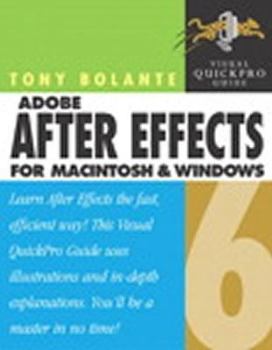After Effects 6.5 for Windows and Macintosh: Visual QuickPro Guide
Part of the Visual Quick Start series, this book covers the improvements which include features such as a revolutionary text engine, support for OpenGL (which greatly accelerates 2D and 3D graphics... This description may be from another edition of this product.
Format:Paperback
Language:English
ISBN:032119957X
ISBN13:9780321199577
Release Date:January 2004
Publisher:Peachpit Press
Length:722 Pages
Weight:2.50 lbs.
Dimensions:1.4" x 7.0" x 9.0"
Customer Reviews
3 ratings
Easy to use reference for a Novice-Intermediate After Effects Student
Published by Thriftbooks.com User , 18 years ago
I found this book to be a very easy to navigate reference for my attempt at learning and using After Effects. I recommend it as an excellent cross-reference resource, especially if you are attending an After Effects classroom. I'm not sure, however, whether a nubie or novice would be able to learn easily just from reading this book alone. Nevertheless, I give this book and the way it is structured, two-thumbs up as far as adding it to anyone's Visual Media Library.
Good Basic Book for After Effects
Published by Thriftbooks.com User , 20 years ago
It says the books in the Visual QuickPro series are similar to the Visual QuickStart series, but QuickPro is for more advanced users. After Effects is, by its very nature, a more advanced application for creating video than, say iMovie. That's because After Effects is a "motion graphics" program with far more features than basic video editing. I think of it as Photoshop with motion and a timeline. However, if you are a beginner at After Effects, this book can still work for you if you start with the early chapters first. Bolante does a good job of giving you an overview of After Effects' interface, palettes, and the workflow. He moves on to how to create, open and close projects, including how to choose your settings and change them. Next is importing files, how to import still images, image sequences, files with alpha channels, footage, etc. He also tells you how to loop footage and remove film pulldown. If you don't know what that is, look at page 60 for a few pages of good explanation. The chapter on Managing Footage does a nice job of helping you organize your footage and understand how to view it. (Do you know about action-safe and title-safe areas?) Like Photoshop, After Effects works in layers (with the addition of audio layers), and Bolante gives you the skinny on creating, naming, hiding, showing and rasterizing them. Editing is all about manipulating the layers by trimming, moving, sequencing, overlapping, splitting, changing the layer's speed, etc. Motion Graphics is all about adding images, motion, changes in size, transparency, blending modes and more. Most of it is done with keyframes. Chapter 7 gives the ins and outs of keyframing. There is a big chapter on masking. Like Photoshop, you use masks to bled various images together. But, you begin, end, rotate, change, scale, show and hide them over time. He covers it all. Special effects are the "magic" part of After Effects, so Bolante devotes a couple of chapters to their intricacies. There are also chapters on creating and animating text, painting on layers, keyframe interpolation (advanced layer techniques), integrating 3D layers, managing complex projects, and, of course, outputting your movies. All-in-all, it is a very thorough book for both Mac and PC users.
many special effects
Published by Thriftbooks.com User , 20 years ago
Adobe is striving mightily to make After Effects the dominant tool for editing animated images, much like Photoshop is the pre-eminent program for editing static images. Bolante shows here why AE has a far more challenging task. Even leaving aside competing tools, AE must handle video editing and audio editing. Here, it needs to synchronise two such tracks, in such ways as the ending of one triggering the start of another. The audio editing is somewhat rudimentary. Other programs that specialise in this have more sophisticated options. But, unsurprisingly,the video editing forms the major part of AE. Several chapters are devoted to it. Many video special effects come right out of the box. Like texturing surfaces, or applying a gradient wipe. Of course, many films will need text to be shown in the video. As expected, you get a panoply of font families to choose from. Along with effects like showing text along a contour that you define. Quite familiar to Photoshop users. But now redone in a broader context. To be sure, this is not a simple book. The complexity of film editing necessitates this. But you should find that most tasks described here are straightforward to do. Though realistically, if you're trying a technique for the first time, many iterations may be needed before you're satisfied.






